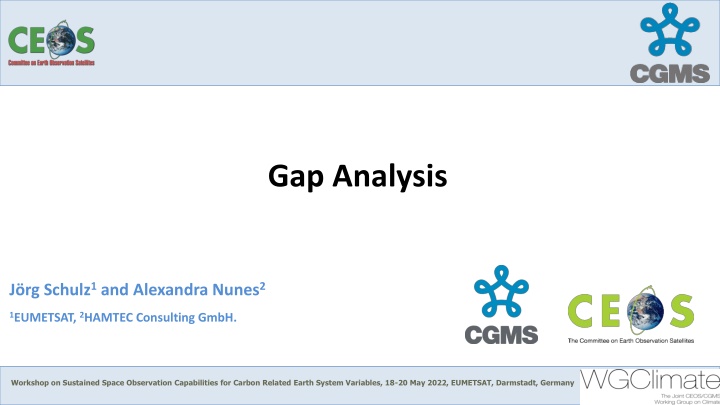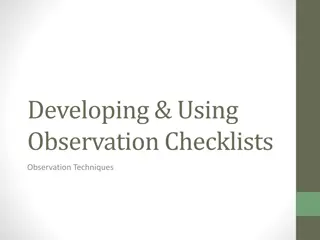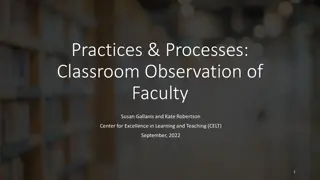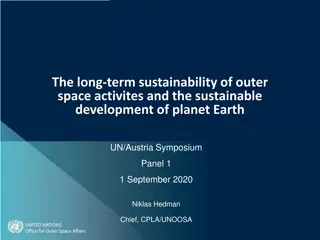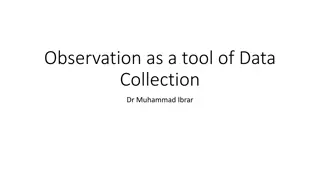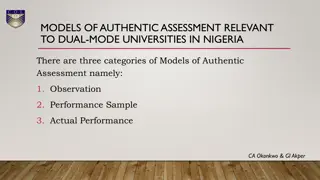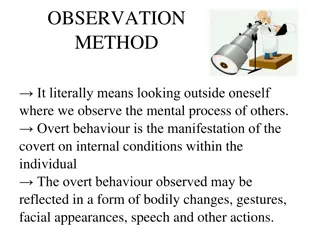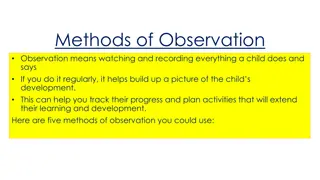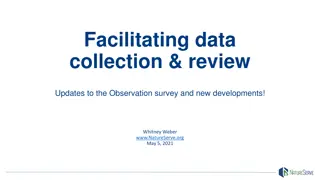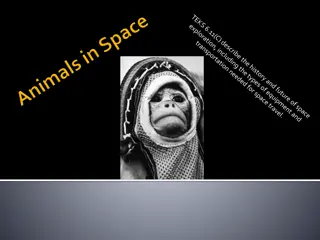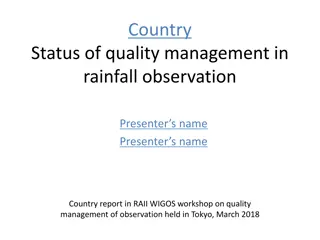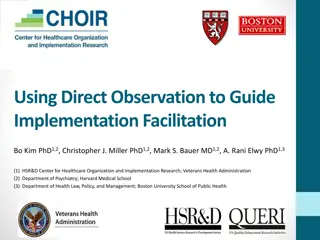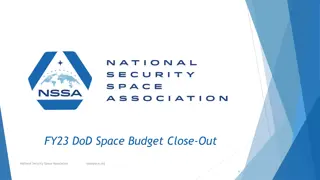Workshop on Space Observation Capabilities for Climate Monitoring
This detailed content covers the Gap Analysis, Context, and Sustainability of Earth System Variables related to carbon, focusing on the Workshop on Sustained Space Observation Capabilities held in Darmstadt, Germany. It delves into the importance of the ECV Inventory, Gap Analysis, and recommendations for mitigating gaps in climate data records. Additionally, it highlights key recommendations from the CEOS-GST Strategy to enhance greenhouse gas monitoring and mitigation efforts.
Download Presentation

Please find below an Image/Link to download the presentation.
The content on the website is provided AS IS for your information and personal use only. It may not be sold, licensed, or shared on other websites without obtaining consent from the author.If you encounter any issues during the download, it is possible that the publisher has removed the file from their server.
You are allowed to download the files provided on this website for personal or commercial use, subject to the condition that they are used lawfully. All files are the property of their respective owners.
The content on the website is provided AS IS for your information and personal use only. It may not be sold, licensed, or shared on other websites without obtaining consent from the author.
E N D
Presentation Transcript
Gap Analysis J rg Schulz1 and Alexandra Nunes2 1EUMETSAT, 2HAMTEC Consulting GmbH. Workshop on Sustained Space Observation Capabilities for Carbon Related Earth System Variables, 18-20 May 2022, EUMETSAT, Darmstadt, Germany
Context of gap analysis Workshop on Sustained Space Observation Capabilities for Carbon Related Earth System Variables, 18-20 May 2022, EUMETSAT, Darmstadt, Germany
Sustaining Space Capabilities for Climate The ECV Inventory fully describes current and planned implementation arrangements for ECVs based on GCOS IP (content is verified) The inventory is unique in linking the available/planned data products and the space segment Gap analysis as performed by WGClimate targets: 1. Identification of gaps in production 2. Identification of gaps in future space segment for GCOS ECVs 3. Identification of opportunities for better usage of past space data 4. Checking closeness to guidelines on data production and QA as well as GCOS Climate Monitoring Principles provided by GCOS ECV Inventory is publically available in the internet and can be used for additional analysis and finding direct access points to climate data records Actions Creation of conditions to deliver climate data records ECV Inventory Population Content Verification Recommendations to mitigate gaps Gap Analysis Completeness of ECV Products Sustainability of space segment Missed data usage opportunities https://climatemonitoring.info/ecvinventory/ Workshop on Sustained Space Observation Capabilities for Carbon Related Earth System Variables, 18-20 May 2022, EUMETSAT, Darmstadt, Germany
GCOS ECV Framework from draft GCOS IP 2022 under review, do not quote or distribute Workshop on Sustained Space Observation Capabilities for Carbon Related Earth System Variables, 18-20 May 2022, EUMETSAT, Darmstadt, Germany
CEOS GST Strategy Recommendations GHG MVS and mitigation Following an earlier discussion with WGClimate leads plan to connect the ECV Inventory v4.1 Gap Analysis with the needs stated in recent CEOS GST Strategy recommendations 1 and 2. Recommendation 1: WGClimate GHG Task Team should consult with the relevant elements of CEOS, including Associates such as ISC, WCRP and GCOS, together with modelers, to check the GHG Implementation roadmap on completeness concerning requirements for terrestrial observation (SIF; NPP, land cover, biomass, etc.) for supporting mitigation actions through the development of MVS. The actions in Annex C of the roadmap shall be complemented as needed. Recommendation 2: The need for parallel inputs to ocean models deemed necessary for the support of MVS and for a wider validation of carbon flux estimates globally should be considered and appropriately combined into the actions in Annex C of the GHG roadmap. This should also be led by the WGClimate GHG TT in cooperation with Ocean VCs and modelling groups, together with GCOS, GOOS, WCRP and individual agencies. Workshop on Sustained Space Observation Capabilities for Carbon Related Earth System Variables, 18-20 May 2022, EUMETSAT, Darmstadt, Germany
Gap analysis on Inventory V4 Concept for Carbon-Cycle exercise Automatic assessment Statistical analysis tools and graphical display for all ECVs Statistical analysis tools and graphical display on the web interface & Analysis of delta to version 3.0 not to be done for upcoming exercise! NEED DISCUSSION ON WAY FORWARD. Gap Analysis Workshop (Q2.2022, Carbon Cycle relevant ECVs in support of the 1st GST) Gap Analysis Report (Q4.2022, for endorsement at the 36th CEOS Plenary (end of November)) Workshop on Sustained Space Observation Capabilities for Carbon Related Earth System Variables, 18-20 May 2022, EUMETSAT, Darmstadt, Germany
Link to Gap Analysis for ECV Inventory v3 Statistical analysis tools and graphical display on the web interface Analysis of delta to v2.0 Automatic assessment Statistical analysis tools and graphical display Status of Gap Analysis 3.0 All the external material that is needed for the GA Report is available and the graphics are produced; Missing still to be written are parts of the text (introduction, completion, consolidation, harmonization) and analysis of progress for earlier addressed ECVs; Detailed analysis per ECV / ECV Product: Assess progress for 8 ECVs addressed for v2.0: CO2, CH4, and other GHG*; Precipitation; LST; LAI*; AGB*; SST, SSS. Addressed ECVs for v3.0: Aerosols, Surface winds, Upper- Air Winds, Water Vapour, Fire*, Land Cover*, Soil Moisture, Sea Level, Sea State, and Ocean Surface Heat Flux. Plan: to merge GA Report 3.0 into GA 4.1 Overlap in scope (common set of analysed ECVs between v4.1 and earlier exercises) and timeline (endorsement at the 36th CEOS Plenary in late November) *ECVs common to Gap Analysis exercise over ECV Inventory v4.1 Workshop on Sustained Space Observation Capabilities for Carbon Related Earth System Variables, 18-20 May 2022, EUMETSAT, Darmstadt, Germany
Steps for the detailed analysis per ECV 1. GCOS ECV definition adequacy 2. ECV coverage in ECV Inventory (existing/planned) identifying gaps in the inventory 3. Situation of the space segment for the ECV products 4. Situation of the ground segment for the ECV products 5. Situation of the science to exploit the measurements 6. Everything that is important in addition 7. Recommendations if needed Workshop on Sustained Space Observation Capabilities for Carbon Related Earth System Variables, 18-20 May 2022, EUMETSAT, Darmstadt, Germany
Resources Workshop on Sustained Space Observation Capabilities for Carbon Related Earth System Variables, 18-20 May 2022, EUMETSAT, Darmstadt, Germany
Proposed list of GCOS [IP 2016] ECV Products Domain ECV ECV Product Note: Stratospheric CH4 profile Tropospheric CH4 column Tropospheric CH4 profile Tropospheric CO2 column Tropospheric CO2 profile Maps of AGB For most of the selected ECVs, there are new ECV Products and/or definitions in the GCOS IP being prepared. This will be detailed separately for each ECV later in this presentation. Atmosphere Carbon Dioxide, Methane and other greenhouse gases Above-ground biomass Estimated fluxes by inversions of observed atmospheric composition - continental Estimated fluxes by inversions of observed atmospheric composition - national High-resolution CO2 column concentrations to monitor point sources [FAPAR (GCOS-154)] Maps of FAPAR for adaptation Maps of FAPAR for modelling Active fire maps Burned areas Fire radiative power Maps of land cover Maps of high-resolution land cover [LAI (GCOS-154)] Maps of LAI for adaptation Maps of LAI for modelling Depth of active layer Permafrost temperature Chlorophyll-a concentration Water leaving radiance Anthropogenic greenhouse-gas fluxes FAPAR Land Fire Land cover Leaf area index Permafrost Ocean Ocean colour Workshop on Sustained Space Observation Capabilities for Carbon Related Earth System Variables, 18-20 May 2022, EUMETSAT, Darmstadt, Germany
Resources provided for each ECV Product GCOS definitions GCOS IP 2016 [GCOS-200] definition (fact sheets with definitions and single-value requirements accessible from https://gcos.wmo.int/en/essential-climate-variables/table) GCOS IP 2022 (draft, in review) definition (the requirements for each ECV Product are now set in three levels (Goal / Breakthrough / Threshold); requirements are also set for timeliness) Excerpt of live ECV Inventory for each GCOS-200 ECV Product (v4.1 to be released in Q3.2022): Existing and Planned datasets (submitted, most of them verified; Existing datasets can be open-ended usually extending to the end-of-life of instrument(s)) Temporal coverage (Existing datasets can be open-ended usually extending into the future to the end-of-life of instrument(s)) Satellites and Instruments used Full extract of live database can be provided separately as needed (.xlsx) Recommendations from previous Gap Analysis exercises (for some ECVs only) Actions from Coordinated Action Plan (2018) (for some ECVs only) CGMS mission risk assessment on mission continuity vis- -vis WIGOS 2040 Workshop on Sustained Space Observation Capabilities for Carbon Related Earth System Variables, 18-20 May 2022, EUMETSAT, Darmstadt, Germany
Workshop on Sustained Space Observation Capabilities for Carbon Related Earth System Variables, 18-20 May 2022, EUMETSAT, Darmstadt, Germany
Workshop on Sustained Space Observation Capabilities for Carbon Related Earth System Variables, 18-20 May 2022, EUMETSAT, Darmstadt, Germany
Workshop on Sustained Space Observation Capabilities for Carbon Related Earth System Variables, 18-20 May 2022, EUMETSAT, Darmstadt, Germany
ECV Greenhouse gases: GCOS definitions ECV PRODUCT DEFINITION GCOS IP 2016 ECV PRODUCT (draft) DEFINITION GCOS IP 2022 CO2 column average dry air mixing ratio Tropospheric CO2column Molecules of CO2in the atmosphere from surface to Tropopause (Molecules/cm2) 2D column integrated number of molecules of the target gas (CO2) divided by that of dry air expressed in mole fraction [ mol/mol] Tropospheric CO2 [profile] Dry air mole fraction of CO2in the troposphere (Mol/mol) 3D field of amount of CO2 (Carbon dioxide, expressed in moles) divided by the total amount of all constituents in dry air (also expressed in moles) [ppm] CO2 mole fraction Tropospheric CH4column Total molecules of CH4in the atmosphere from surface to Tropopause (Molecules/cm2) CH4 column average dry air mixing ratio 2D column integrated number of molecules of the target gas (CH4) divided by that of dry air expressed in mole fraction [nmol/mol] Tropospheric CH4 [profile] Dry air mole fraction of CH4in the troposphere (Mol/mol) 3D field of amount of CH4 (Methane, expressed in moles) divided by the total amount of all constituents in dry air (also expressed in moles) [ppb] CH4 mole fraction Stratospheric CH4 [profile] Dry air mole fraction of CH4in the stratosphere (Mol/mol) 3D field of amount of N2O (expressed in moles) divided by the total amount of all constituents in dry air (also expressed in moles) [ppb] N2O mole fraction Workshop on Sustained Space Observation Capabilities for Carbon Related Earth System Variables, 18-20 May 2022, EUMETSAT, Darmstadt, Germany
ECV Greenhouse gases: ECV Inventory ECV PRODUCT GCOS IP 2016 ECV Inventory Note: Some existing datasets are open-ended and will be extended until the end-of-life of the contributing instrument(s). The lack of planned datasets is partly justified by this exception for Stratospheric CH4 profile. 22 existing entries covering 09.2002 - ; Envisat-SCIAMACHY-nadir, Aqua-AIRS, GOSAT-1-TANSO-FTS, GOSAT-2-TANSO-FTS/2, OCO-2-OCO. Tropospheric CO2column 11 planned entries covering 09.2002 - ; Aqua-AIRS, GeoCarb-GeoCarb, GOSAT-1-TANSO-FTS, ISS OCO-3-OCO. 2 existing entries covering 12.2009 - ; GOSAT-1-TANSO-FTS, GOSAT-2-TANSO-FTS/2. Tropospheric CO2 [profile] 22 existing entries covering 10.2002 - ; Envisat-SCIAMACHY-nadir, Aqua-AIRS, CloudSat-CPR, GOSAT-1-TANSO-FTS, GOSAT-2-TANSO-FTS/2, Metop- A-IASI, Metop-B-IASI. Tropospheric CH4column 12 existing entries covering 09.2002 - ; Aqua-AIRS, CloudSat-CPR, GOSAT-1-TANSO-FTS, GOSAT-2-TANSO-FTS/2, Metop-A-IASI. Tropospheric CH4 [profile] 9 planned entries covering 09.2002 - ; Aqua-AIRS, GeoCarb-GeoCarb. 1 existing entry covering 06.2007 - 11.2015 [newer version of dataset covers 06.2007-12.2017]; MetOp-A - IASI. Stratospheric CH4 [profile] Workshop on Sustained Space Observation Capabilities for Carbon Related Earth System Variables, 18-20 May 2022, EUMETSAT, Darmstadt, Germany
ECV Greenhouse gases: Recommendations and Actions ECV PRODUCT GCOS IP 2016 Recommendations from previous Gap Analysis Actions from Coordinated Action Plan (2018) #11: CEOS and CGMS Agencies with interests in and/or mandates for developing CO2 climate data records to strive for ensuring consistent, well-calibrated, bias-free time- series that can be continued into the future. They will coordinate their efforts in consultation with the AC-VC, WGClimate and WGCV to ensure appropriate use of data from multiple sensors. Agencies shall register resulting plans for new CO2 CDRs with the ECV Inventory. #12: WGClimate and GCOS Secretariat to monitor the status of the GCOS Action T71 [Prepare for a Carbon-monitoring system] and to report back to CEOS and CGMS. #10: To ensure continuity in CO2 CDRs, agencies or partner entities are requested to commit to the generation of CDRs in all relevant spectral domains including SWIR from existing or approved missions measuring tropospheric and total column CO2. #11: Agencies or related entities are encouraged to systematically link their satellite- based derivation of CO2 sources and sinks with data from insitu/ground-based infrastructure and modelling framework(s) in order to estimate Earth-surface CO2 fluxes (see GCOS IP 2016 Action T71) and provide feedback on their plans/progress. Tropospheric CO2 column Tropospheric CO2 [profile] (no specific recommendations) (same as above) #14: CEOS and CGMS Agencies with interests in and/or mandates for developing CH4 climate data records to strive for ensuring consistent, well-calibrated, bias-free time- series continued into the future. They will coordinate their efforts in consultation with the AC-VC, WGClimate and WGCV to ensure appropriate use of data from multiple sensors. Agencies shall register resulting plans for new CO2 CDRs with the ECV Inventory. #13: Agencies to plan for the generation of tropospheric column CH4 ECV data records based on the data collected by instruments on missions such as Sentinel-5P, MERLIN, GeoCarb, Sentinel-5, FY-3D, GOSAT-2. Tropospheric CH4 column Tropospheric CH4 [profile] (no specific recommendations) (same as above) #13: The AC-VC, in collaboration with WGClimate, to develop a plan to address the measurement gap for stratospheric CH4 profiles in order to provide FCDR/CDR in the future. This plan shall be subject to endorsement by WGClimate. Stratospheric CH4 [profile] #12: The AC-VC to develop a plan to address the measurement of stratospheric CH4 profiles in order to fill the gap for the related FCDR/CDRs. Workshop on Sustained Space Observation Capabilities for Carbon Related Earth System Variables, 18-20 May 2022, EUMETSAT, Darmstadt, Germany
ECV Ocean Colour: GCOS definitions ECV PRODUCT DEFINITION GCOS IP 2016 ECV PRODUCT (draft) DEFINITION GCOS IP 2022 Water leaving radiance Water leaving radiance Amount of light emanating from within the ocean Amount of light emanating from within the ocean Chlorophyl-a concentration Concentration of chlorophyll-a pigment in the surface water [ g l-1] Chlorophyl-a concentration* Concentration of chlorophyll-a pigment in the surface water [ g l-1] Note: No apparent change in the definitions, but Annex A of draft GCOS IP 2022 has a typo for this ECV (partial repeat of table for Water leaving radiance, and consequent omission of name and definition of Chl-a concentration). Workshop on Sustained Space Observation Capabilities for Carbon Related Earth System Variables, 18-20 May 2022, EUMETSAT, Darmstadt, Germany
ECV Ocean Colour: ECV Inventory & Recommendations and Actions ECV PRODUCT GCOS IP 2016 Notes: ECV Inventory Known gaps -- Input incomplete from ESA-CCI and C3S, and input missing from NASA; 4 existing entries covering 09.1997 - ; Aqua-MODIS, Envisat-MERIS, OrbView-2/SeaStar-SeaWiFS, SNPP-VIIRS. Water leaving radiance 5 planned entries covering 09.1997 - ; Aqua-MODIS, Envisat-MERIS, OrbView-2/SeaStar-SeaWiFS, SNPP-VIIRS. 4 existing entries covering 09.1997 - ; Aqua-MODIS, Envisat-MERIS, OrbView-2/SeaStar-SeaWiFS, SNPP-VIIRS. OC was not analysed in previous GA exercises, hence no Recommendations or Actions for this ECV. Chlorophyl-a concentration 5 planned entries covering 09.1997 - ; Terra/Aqua-MODIS, Envisat-MERIS, OrbView-2/SeaStar-SeaWiFS, SNPP-VIIRS, GCOM-C-SGLI. Workshop on Sustained Space Observation Capabilities for Carbon Related Earth System Variables, 18-20 May 2022, EUMETSAT, Darmstadt, Germany
ECV Anthropogenic GHG fluxes: GCOS definitions ECV PRODUCT * (draft) DEFINITION GCOS IP 2022 ECV PRODUCT * DEFINITION GCOS IP 2016 Total estimated fluxes by coupled data assimilation/ models with observed atmospheric continental GHG emission gridmaps (modelled output, using proxy for the spatial distribution) Estimated fluxes by inversions of observed atmospheric composition - continental GHG emission/ removals (modelled using inversion of atmospheric composition), continental scale Total estimated fluxes by coupled data assimilation/ models with observed atmospheric national High-resolution footprint around point sources National estimates derived from highly resolved GHG emission gridmaps (modelled output, using proxy for the spatial distribution at fine-scale resolution) [kg CO2eq /m2/s] Spatially resolved GHG emission plume around local source [kg CO2 /m2/s] F-Gas emissions are anthropogenic and mainly originating from chemical industrial processes and Fgas- related product use. The different F-gases have different, all very high global warming potentials. [ton CO2eq /yr for the region*] (*country) Anthropogenic F-gas emissions from industrial processes and product use Estimated fluxes by inversions of observed atmospheric composition - national GHG emission/ removals (modelled using inversion of atmospheric composition), national scale Anthropogenic N2O emissions from fossil fuel use, industry, agriculture, waste and products use, indirect from n-related emissions/ depositions Anthropogenic N2O emissions are mainly originating from fuel combustion, industry, agriculture, waste, products use (including indirect emissions from leaching and run-off, from NOx emissions). [ton N2O /yr for the region*] (*country) Anthropogenic CH4 emissions are mainly originating from fermentation processes in waste (landfills), manure, enteric fermentation, but also from fossil fuel extraction, transmission and distribution and use, and industrial processes. [ton CH4 /yr for the region*] (*country) Anthropogenic CH4 emissions from fossil fuel, waste, agriculture, industrial processes and fuel use Hi-res CO2 column concentrations to monitor point sources Spatially resolved GHG emission plume around local source Short and long cycle C emissions from land use, land-use [change] and forestry (including carbon stock gains and losses of biomass burning, disease, harvest, net deforestation). [ton CO2 /yr for the region*] (*country or region) Anthropogenic CO2 emissions/ removals by land categories Anthropogenic long-cycle C emissions are mainly originating from combustion of fossil fuels, and for about 10% also from non-combustion sources, such as cement production, ferrous and non-ferrous metal production processes, urea production, agricultural liming and solvent use. [ton CO2eq /yr for the region*] (*country) Anthropogenic CO2 emissions from fossil fuel use, industry, agriculture, waste and products use * See notes on next slide Workshop on Sustained Space Observation Capabilities for Carbon Related Earth System Variables, 18-20 May 2022, EUMETSAT, Darmstadt, Germany
ECV Anthropogenic GHG Fluxes: ECV Inventory & Recommendations and Actions ECV Inventory: ABSOLUTE GAP: There are no registered datasets addressing any of the GCOS IP 2016 (GCOS-200) ECV Products listed for this ECV, and no known (to the ECV Inventory Support Team) candidate datasets either. Recommendations and Actions: Anthropogenic GHG fluxes was not analysed in previous Gap Analysis exercises, hence no Recommendations or Actions for this ECV. Notes on GCOS definitions (previous slide): The first two ECV Products are redefined for the GCOS IP 2022 The current GCOS fact sheet lists two additional ECV products that were not previously considered space observable: "Emissions from fossil fuel use, industry, agriculture and waste sectors" and "Emissions/removals by IPCC land categories". It is not clear yet which ECV Products can be considered space-observable Workshop on Sustained Space Observation Capabilities for Carbon Related Earth System Variables, 18-20 May 2022, EUMETSAT, Darmstadt, Germany
ECV Above-ground biomass: GCOS definitions & ECV Inventory ECV PRODUCT DEFINITION GCOS IP 2016 ECV PRODUCT (draft) DEFINITION GCOS IP 2022 Mass of live and/or dead organic matter in terrestrial vegetation Mass of live and/or dead organic matter in terrestrial vegetation. [Mass of dry weight in metric tons] Maps of above-ground biomass Above-ground biomass Notes: ECV PRODUCT GCOS IP 2016 ECV Inventory No apparent change in the definitions Temporal coverage without MODIS NPP / GPP datasets starts in 01.2010 (ESA-CCI). 9 existing entries covering 01.2000* - ( *existing MODIS datasets of NPP and GPP have been submitted as AGB and are under review); *Aqua/Terra-MODIS, ALOS-PALSAR, ALOS-2-PALSAR-2, Envisat- ASAR, ICESat-GLAS, Sentinel-1A-SAR-C, Sentinel-1B-SAR-C. Maps of above-ground biomass 1 planned entry (in the meantime released) covering 04.2019 - ; ISS GEDI-GEDI; Workshop on Sustained Space Observation Capabilities for Carbon Related Earth System Variables, 18-20 May 2022, EUMETSAT, Darmstadt, Germany
ECV Above-ground Biomass: Recommendations and Actions ECV PRODUCT GCOS IP 2016 Recommendations from previous Gap Analysis Actions from Coordinated Action Plan (2018) #25: CEOS and WMO to update the MIM and OSCAR databases with respect to Above-ground Biomass, based on information from the gap analysis report provided by WGClimate. This action shall be performed together with Actions #3 and #4. #27: CEOS and CGMS Agencies, with interests in and/or mandates for developing instruments dedicated to the derivation of Above Ground Biomass, to coordinate their efforts to reach continuous measurement availability. They will coordinate their efforts with WGClimate to ensure future provision of adequate CDRs. #28: CEOS and CGMS Agencies, with interests in and/or mandates for developing instruments dedicated to the derivation of Above Ground Biomass, to coordinate their efforts to develop high resolution SAR/LIDAR measurements. They will coordinate their efforts with WGClimate to ensure future provision of adequate CDRs. #22: Both the CEOS MIM and WMO OSCAR databases should be updated in a consistent fashion to reflect the Above- ground Biomass ECV and in doing so are co-aligned. #23: All C-band and L-band SAR measurements of CEOS and CGMS agencies, should be made openly available by space agencies operating the instruments for the construction of CDRs for Above-ground Biomass. The combination of L-band and C-band measurements will help extend the sensitivity of existing estimates. #24: Space agencies to plan for continuity of measurements, such as to be provided by BIOMASS and GEDI. #25: Space Agencies to plan for high-resolution data provision in support of REDD+ type applications leading to the Global Stocktake process. Maps of above-ground biomass Note: By the time of the previous analysis of this ECV (2017-2018) there were no datasets registered in the ECV Inventory. Workshop on Sustained Space Observation Capabilities for Carbon Related Earth System Variables, 18-20 May 2022, EUMETSAT, Darmstadt, Germany
ECV Land Cover: GCOS definitions ECV PRODUCT (draft) DEFINITION GCOS IP 2022 ECV PRODUCT DEFINITION GCOS IP 2016 Primary unit are categories (binary variables such as forest or cropland) or continuous variables classifiers (e.g. fraction of tree canopy cover in percent) Land cover is defined as the observed (bio)- physical cover on the Earth s surface. [Primary units are categories (binary variables such as forest or cropland) or continuous variables classifiers (e.g. fraction of tree canopy cover in percent). Secondary outputs include surface area of land cover/use types and land cover/use changes (in ha). UN/FAO Land Cover Classification System (LCCS) + C3/C4 sub-classification should be used with cross-walking tables to other common classifications] Maps of land cover Maps of land cover Primary unit are categories (binary variables such as forest or cropland) or continuous variables classifiers (e.g. fraction of tree canopy cover in percent). Secondary outputs include surface area of land cover/use types and land cover/use changes (in ha) Maps of high resolution land cover Land cover is defined as the observed (bio)- physical cover on the Earth s surface. [Primary units are categories (binary variables such as forest or cropland) or continuous variables classifiers (e.g. fraction of tree canopy cover in percent). Secondary outputs include surface area of land cover/use types and land cover/use changes (in ha).] * Maps of key IPCC land use, related changes and land management types IPCC Good Practice Guidelines land use categories (forest land, cropland, grassland, wetland, settlement, other land) Maps of high resolution land cover Land cover is defined as the observed (bio)- physical cover on the Earth s surface. [Primary units are categories (binary variables such as forest or cropland) or continuous variables classifiers (e.g. fraction of tree canopy cover in percent). Secondary outputs include surface area of land cover/use types and land cover/use changes (in ha).] Notes: Maps of key IPCC land classes, related changes and land management types In the GCOS IP 2016 the third ECV Product is not classified as space- observable, but in the draft GCOS IP 2022, the use of satellite data is mentioned. From the information available it is not clear whether the definitions of the ECV Products have changed. Workshop on Sustained Space Observation Capabilities for Carbon Related Earth System Variables, 18-20 May 2022, EUMETSAT, Darmstadt, Germany
ECV Land cover: ECV Inventory & Recommendations and Actions Recommendations and Actions: This ECV was analysed for the GA exercise of 2019, but the analysis has not yet been consolidated. Therefore there are no formal Recommendations or Actions. Notes from the contributors pointed to missing datasets -- NASA MODIS LC (in the meantime included in the ECV Inventory and under review) and NOAA VIIRS surface types (TBC) and reduced number of classes for some entries. By the time of the analysis there were no entries addressing HRLC. ECV PRODUCT GCOS IP 2016 ECV Inventory 14 existing entries covering 07.1981 - ; NOAA-7/9/10/11/14/16/18-AVHRR/2/3, Aqua/Terra-MODIS, Envisat-MERIS, PROBA-V-Vegetation-P, SPOT-4-Vegetation, Sentinel-3A/B-OLCI, SNPP-VIIRS. Maps of land cover 1 planned entry covering 07.1981 - ; NOAA-7/9/11/14/16/18-AVHRR/2/3. 1 planned entry covering 01.1990-12.2020 for three areas of interest: Sahel band, Siberia, and Amazon basin; Envisat-ASAR, ERS-1/2-AMI-SAR, Landsat-5-TM, Landsat-7- ETM+, Landsat-8-OLI, Sentinel-1A/B-SAR-C, Sentinel-2A/B-MSI. Maps of high resolution land cover ECV Inventory: The planned entry for HRLC will be published later this year (ESA-CCI); The ECV Product Maps of IPCC was not listed in the database as space- observable, following the GCOS IP 2016. Workshop on Sustained Space Observation Capabilities for Carbon Related Earth System Variables, 18-20 May 2022, EUMETSAT, Darmstadt, Germany
ECV Fire: GCOS definitions ECV PRODUCT DEFINITION GCOS IP 2016 ECV PRODUCT (draft) DEFINITION GCOS IP 2022 Burned area means the area of burned vegetation. X_area means the horizontal area occupied by X within the grid cell. The extent of an individual grid cell is defined by the horizontal coordinates and any associated coordinate bounds or by a string valued auxiliary coordinate variable with a standard name of region. [m2] Burned area means the area affected by the fire, including natural vegetation and croplands. X_area means the horizontal area occupied by X within the grid cell. The extent of an individual grid cell is defined by the horizontal coordinates and any associated coordinate bounds or by a string valued auxiliary coordinate variable with a standard name of region. Burnt area Burnt Area Presence of a temporal thermal anomaly within a grid cell. Those thermal anomalies that are permanent should be linked to other sources of thermal emission (volcanos, gas flaring, industrial or power plants). Generally, the active fire maps are defined by the date/hour when the thermal anomaly was detected. [m2] Presence of a temporal thermal anomaly within a grid cell. Those thermal anomalies that are permanent should be linked to other sources of thermal emission (volcanos, gas flaring, industrial or power plants). Generally, the active fire maps are defined by the date/hour when the thermal anomaly was detected. Active Fires Active Fire Maps Amount of energy released by area unit. Commonly it is expressed in W/m2. This variable is a function of actual temperature of the active fire at the satellite overpass and the proportion of the grid cell being burned. [W/m2] Amount of energy released by area unit. Commonly it is expressed in W/m2. This variable is a function of actual temperature of the active fire at the satellite overpass and the proportion of the grid cell being burned. Fire Radiative Power Fire Radiative Power (FRP) Note: Combustion completeness (CC) / also termed Burning efficiency (BE) Proportion of pre-fire biomass consumed by the fire. [unitless] The new ECV Product seems to be considered space-observable in the draft GCOS IP 2022 Workshop on Sustained Space Observation Capabilities for Carbon Related Earth System Variables, 18-20 May 2022, EUMETSAT, Darmstadt, Germany
ECV Fire: ECV Inventory & Recommendations and Actions Recommendations and Actions: This ECV was analysed for the GA exercise of 2019, but the analysis has not yet been consolidated. Therefore there are no formal Recommendations or Actions. Notes from the contributors pointed to missing datasets -- NASA MODIS BA (in the meantime included in the ECV Inventory and under review). The ECV Product Active Fire Maps was not analysed. By the time of the analysis there were no entries for AFM registered in the ECV Inventory. ECV PRODUCT GCOS IP 2016 ECV Inventory 19 existing entries covering 01.1982 - ; NOAA-7/9/11/14/16/18/19-AVHRR/2/3, Landsat- 5-TM, Landsat-7-ETM+, Landsat-8-OLI, Landsat-8- TIRS, Aqua/Terra-MODIS, Envisat-MERIS, SNPP- VIIRS, PROBA-V-Vegetation-P, Sentinel-3A/B-OLCI, Sentinel-3A/B-SLSTR, Sentinel-2A/B-MSI. Burnt Area 1 planned entry from JAXA (under review) covering 03.2000 - ; Terra/Aqua-MODIS, GCOM-C-SGLI Active Fire Maps 8 existing entries covering 03.2000 - ; Aqua/Terra-MODIS, SNPP-VIIRS. Fire Radiative Power 3 planned entries covering 01.2003 - 12.2018; Aqua/Terra-MODIS, Meteosat-8/9-SEVIRI. Workshop on Sustained Space Observation Capabilities for Carbon Related Earth System Variables, 18-20 May 2022, EUMETSAT, Darmstadt, Germany
ECV Leaf Area Index: GCOS definitions ECV PRODUCT DEFINITION GCOS IP 2016 ECV PRODUCT (draft) DEFINITION GCOS IP 2022 Maps of LAI for modelling Effective Leaf Area Index Effective Leaf Area Index; The LAI value that would produce the same indirect ground measurement as that observed assuming random foliage distribution. ( LAIeff=LAItrue x canopy clumping index ) (Fang et al., 2019) True Leaf Area Index ((LAItrue)) of a plant canopy or ecosystem is defined as one half of the total green leaf area per unit horizontal ground surface area and measures the area of leaf material present in the specified environment. (Projection to the underlying ground along the normal to the slope). [m2/m2] Maps of LAI for adaptation Effective Leaf Area Index Leaf Area Index Note: In the GCOS IP 2016 the split of this ECV into two ECV Products was introduced depending on the application (modelling or adaptation). The approach in the draft GCOS IP 2022 returns to a single ECV Product, similar to GCOS-154 ( Satellite Supplement [to the GCOS IP]). Workshop on Sustained Space Observation Capabilities for Carbon Related Earth System Variables, 18-20 May 2022, EUMETSAT, Darmstadt, Germany
ECV Leaf Area Index: ECV Inventory & Recommendations and Actions ECV Inventory: ECV PRODUCT GCOS IP 2016 ECV Inventory Most of the LAI datasets registered in the ECV Inventory were initially (2016-2017) labelled simply as LAI, before the publication of the GCOS IP in late 2016 introduced the split into ECV Products (per application). In later versions of the ECV Inventory, some older entries were re-labelled by the contributors as for modelling , but never for adaptation . *Two entries registered in 2016- 2017 were never re-labelled, thus LAI (GCOS-154) remained as an ECV Product in the ECV Inventory. 11 existing entries covering 07.1981 - ; NOAA-7/9/11/14/16/17-AVHRR/2/3, Aqua/Terra-MODIS, SNPP-VIIRS, PROBA- V-Vegetation-P, SPOT-4/5-Vegetation, Sentinel-3A/B-OLCI. Maps of LAI for modelling 1 planned entry covering 09.1981 - ; NOAA-7/9/11/14/16/17-AVHRR/2/3, PROBA-V-Vegetation-P, SPOT-4/5- Vegetation. Maps of LAI for adaptation (no entries registered) 2 existing entries covering 07.1981 - ; NOAA-7/9/11/14/16/18/19-AVHRR/2/3, Meteosat-8/9-SEVIRI. LAI (GCOS-154)* Recommendations from previous Gap Analysis Actions from Coordinated Action Plan (2018) ECV PRODUCT GCOS IP 2016 Maps of LAI for modelling #21: LSI-VC should assess the climate user community needs for LAI data records that are not currently being exploited from existing missions (e.g. Sentinel-2, Landsat), and inform WG Climate of their findings to enable further planning for needed LAI data records. #24: The LSI-VC and GCOS TOPC to assess the climate user community needs for LAI that are not currently exploited from existing missions to enable planning for further Leaf Area Index data records as appropriate. Resulting plans at Agencies to generate climate data records shall be registered with the ECV Inventory. Maps of LAI for adaptation LAI (GCOS-154) Workshop on Sustained Space Observation Capabilities for Carbon Related Earth System Variables, 18-20 May 2022, EUMETSAT, Darmstadt, Germany
ECV FAPAR: GCOS definitions ECV PRODUCT DEFINITION GCOS IP 2016 ECV PRODUCT (draft) DEFINITION GCOS IP 2022 FAPAR is the fraction of the incoming radiation in the 400-700 nm band absorbed by the leaves, which can be used for photosynthesis. Definitions differ according to illumination conditions and leaf state. FAPAR is defined as the fraction of photosynthetically active radiation (PAR; solar radiation reaching the surface in the 0.4-0.7 m spectral region) that is absorbed by vegetation canopy. Both black-sky (assuming only direct radiation) and white-sky (assuming that all the incoming radiation is in the form of isotropic diffuse radiation) FAPAR values may be considered. Similarly FAPAR can also be angularly integrated or instantaneous (i.e., at the actual sun position of measurement). Leaves-only FAPAR refers to the fraction of PAR radiation absorbed by live leaves only, i.e., contributing to the photosynthetic activity within leaf cells. [N/A] Maps of FAPAR for modelling FAPAR is the fraction of the incoming radiation in the 400-700 nm band absorbed by the leaves, which can be used for photosynthesis. Definitions differ according to illumination conditions and leaf state. Fraction of Absorbed Photosynthetically Active Radiation Maps of FAPAR for adaptation Note: In the GCOS IP 2016 the split of this ECV into two ECV Products was introduced depending on the application (modelling or adaptation). The approach in the draft GCOS IP 2022 returns to a single ECV Product, similar to GCOS-154 ( Satellite Supplement [to the GCOS IP]). Workshop on Sustained Space Observation Capabilities for Carbon Related Earth System Variables, 18-20 May 2022, EUMETSAT, Darmstadt, Germany
ECV FAPAR: ECV Inventory & Recommendations and Actions ECV Inventory: ECV PRODUCT GCOS IP 2016 ECV Inventory Most of the FAPAR datasets registered in the ECV Inventory were initially (2016-2017) labelled simply as FAPAR, before the publication of the GCOS IP in late 2016 introduced the split into ECV Products (per application). In later versions of the ECV Inventory, some older entries were re-labelled by the contributors as for modelling , but never for adaptation . 7 existing entries covering 09.1981 - ; NOAA-7/9/11/14/16/17-AVHRR/2/3, SPOT-4/5-Vegetation, PROBA-V-Vegetation-P, Terra-MODIS, Sentinel-3A/B-OLCI. Maps of FAPAR for modelling 1 planned entry covering 09.1981 -(with 4 months gap between NOAA-11 and -14); NOAA-7/9/11/14/16/17-AVHRR/2/3, SPOT-4/5-Vegetation, PROBA-V-Vegetation-P. * Three entries registered in 2016-2017 were never re- labelled, thus FAPAR (GCOS-154) remained as an ECV Product in the ECV Inventory. Maps of FAPAR for adaptation no entries registered 3 existing entries covering 07.1981 - ; NOAA-7/9/11/14/16/18/19-AVHRR/2/3, Meteosat-8/9-SEVIRI. FAPAR (GCOS-154)* Recommendations and Actions: FAPAR was not analysed in previous Gap Analysis exercises, hence no Recommendations or Actions for this ECV. Workshop on Sustained Space Observation Capabilities for Carbon Related Earth System Variables, 18-20 May 2022, EUMETSAT, Darmstadt, Germany
ECV Permafrost: GCOS definitions ECV PRODUCT DEFINITION GCOS IP 2016 ECV PRODUCT (draft) DEFINITION GCOS IP 2022 Ground temperatures measured at specified depths along profiles Permafrost is subsurface earth material that remains continuously at or below 0 C throughout at least two consecutive years, usually for extended time periods up to many millennia. Product definition: Ground temperatures measured at specified depths along profiles. [ C] Thermal State of Permafrost Permafrost Temperature (PT) Active Layer Thickness Thickness of seasonally thawed ground measured in (cm) The surface layer of the ground, subject to annual thawing and freezing in areas underlain by permafrost. Thickness of seasonally thawed soils measured in (cm), surface displacements measured in (cm), surface subsidence. [cm] Notes: Active Layer Thickness (ALT) No apparent changes in the definitions of the two ECV Products inherited from the GCOS IP 2016; The new ECV Products listed in the draft GCOS IP 2022 are apparently space-observable . Fraction of permafrost-underlain area within a grid cell's horizontal area. Permafrost is subsurface earth material that remains continuously at or below 0 C throughout at least two consecutive years, usually for extended time periods up to many millennia. [fraction] Permafrost extent Global dataset of surface velocity time series measured/computed on single rock glacier units. [m/yr] Rock Glacier Velocity (RGV) Workshop on Sustained Space Observation Capabilities for Carbon Related Earth System Variables, 18-20 May 2022, EUMETSAT, Darmstadt, Germany
ECV Permafrost: ECV Inventory & Recommendations and Actions ECV Inventory: ECV PRODUCT GCOS IP 2016 ECV Inventory The generation of these ESA-CCI Permafrost CDRs relies on other CDRs produced by the ESA-CCI Projects on Land Cover, LST, and Snow. Additional satellites and instruments used to generate such CDRs include: Sentinel-3A/B - SLSTR, MetOp-A/B/C - AVHRR/3, Meteosat-8/9/10/11 - SEVIRI, GOES - IMAGER, MTSAT- 1/2 - JAMI, SPOT-4 - Vegetation, PROBA-V - Vegetation- P, Envisat - MERIS, DSMP-F8/11/13 - SSM/I, and DSMP- F17 - SSMIS. 1 planned entry (in the meantime released and extended) covering 01.1998 - 12.2018; Envisat-AATSR, ERS-1/2-ATSR, Terra/Aqua-MODIS. Thermal State of Permafrost 1 planned entry (in the meantime released and extended) covering 01.1998 - 12.2018; Envisat-AATSR, ERS-1/2-ATSR, Terra/Aqua-MODIS. Active Layer Thickness The input from the ESA-CCI project is outdated, and the current temporal coverage is 01.1997 12.2019. No information on further plans was provided. Recommendations and Actions: Permafrost was not analysed in previous Gap Analysis exercises, hence no Recommendations or Actions for this ECV. Workshop on Sustained Space Observation Capabilities for Carbon Related Earth System Variables, 18-20 May 2022, EUMETSAT, Darmstadt, Germany
Availability of people (x=av) Last name ECVs Hall Fire de Jong Fire van der Tol LAI, FAPAR Zechlau N/A Kachi Ocean Mecklenburg (Albrecht will ask) Cipollini Ocean Colour Liu GHG / AGB Title Mrs. Mr. Mr. Mrs. Mrs. Mrs. Mr. Mrs. First name Joanne Mark Christiaan Sabrina Misako Susanne Paolo Junjie Domain Land Land Land N/A Day 1 AM x/o x o x x x x x Day 1 PM x x o x x x x x Day 2 AM x/o x x x x x x x Day 2 PM x x x x x x x x Day 3 AM x/o x x x x x x x Ocean Atmosphere / Land Mr. Mr. Mrs. Mr. Mr. Heikki Ruben Nadine Osamu Richard Pohjola Urraca Gobron Ochiai Engelen ? GHG and albedo/snow LAI, FAPAR AFOLU and LUCLUF GHG, Anthropogenic GHG fluxes, Fire, biosphere AGB ? N/A ? GHG Ocean Color, FAPAR GHG GHG ? LAI, FAPAR Land Cover GHG? Anthropogenic GHG fluxes? Land? (Fire? Land Cover?) GHG, Anthropogenic GHG fluxes? ? ? ? Permafrost x x o x x x x x x x x x o x x x x o x x x x o x x Land Land Land Atmosphere/Land Mr. Mr. Mrs. Mr. Mr. Mrs. Mrs. Mr. Mr. Ms. Mr. Mr. Mr. Mr. Mrs. Mr. Mr Mr. Ben Peng Alexandra Adrian John Wenying Julia Albrecht Joerg Else Mark Clement Stephen Christian Kanjana Lars Peter Jeff Kevin Poulter Zhang Nunes Guzman Worden Su Marshall von Bargen Schulz Swinnen Friedl Albergel Plummer Retscher Koedkurang Riishojgaard Privette Schaefer Land x x ? x x x x x x x x x x x x x x x x x x x x ? x x x x x x x o x x x x x x x x x o x N/A x x x x x x x x x Atmosphere Atmosphere x x x x o x x x x x x o x x x x x x o x x x x x x o x o x x x x o x x x x x x o x o Land Land Atmosphere (Land)? Land Atmosphere (Land)? Land Land Land Workshop on Sustained Space Observation Capabilities for Carbon Related Earth System Variables, 18-20 May 2022, EUMETSAT, Darmstadt, Germany Mr. Shaun Quegan AGB Mr Anthony Rea ?
Proposal Wednesday afternoon: GHG, Anthropogenic GHG fluxes Thursday morning: Leaf Area Index, FAPAR, AGB, Fire Thursday afternoon: Permafrost, Land Cover, Ocean Colour Need leaders for each ECV that can report on Friday morning CEST. Workshop on Sustained Space Observation Capabilities for Carbon Related Earth System Variables, 18-20 May 2022, EUMETSAT, Darmstadt, Germany
GHG, GHG anthropogenic fluxes: John Worden, Julia Marshal, Richard Engelen, Peng Zang, Albrecht v. Bargen, Heikki P., Permafrost: Kevin Schaefer, J rg Schulz Fire: Mark de Jong, Joanne Hall, Clement Albergel LAI and FAPAR: Nadine Gabrone, Jeff Privette, Else Swinnen, Christian van der Tol, Clement Albergel Land Cover: Osamu, Mark Friedl, Stephen Plummer; Clement Albergel AGB: Junjie Liu, Ben Poulter Ocean Colour: Paolo Cipollini, Misako Wenying Su Workshop on Sustained Space Observation Capabilities for Carbon Related Earth System Variables, 18-20 May 2022, EUMETSAT, Darmstadt, Germany
